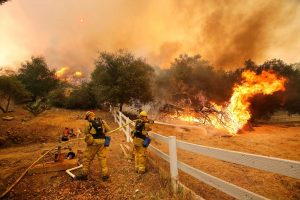California heat wave: The growing flame
September 8, 2017
On the first weekend of September, the Bay Area fell under a cloud of windy heat. Temperatures rose to a record high of 106℉ on Friday, Sept. 1 shattering the previous record of 103°F from June 14, 2000. Throughout the weekend, the temperatures had dwindled to 102°F on Saturday and 100°F on Sunday.

In southern California, Los Angeles battled a large wildfire that burned through the Verdugo Mountains in Burbank which had destroyed four homes and forced evacuations in multiple neighborhoods.
More wildfires sparked up over the state of California, including a blaze that reached a 2,700-year-old grove of giant sequoia trees near Yosemite National Park. The smoke created a blanket of smog on top of nearby cities in the Sierra Nevada.
Ben Santer, a climate scientist in San Ramon and a member of National Academy of Sciences, believes the recent behavior is the normal weather pattern. In an interview with the San Jose Mercury News, he said, “This is expected behavior. It’s not some vast scientific surprise. We know that by burning fossil fuels we are increasing heat-trapping gases in the atmosphere, and that’s warming the lower atmosphere and Earth’s surface,” Santer said. “The expectation has been that we are going to see more heat records, and that’s what we are seeing.”
Back at MVHS, administration decided to cancel all games and practices to prevent possible injury to athletes during the heat wave on Friday, Sept. 1. Many students were relieved when hearing canceled practice, especially junior Melinda Xiemen.
“I got really excited when I heard they canceled practice because running in the heat is extremely exhausting and draining,” Xiemen said. “I was happy that after a long week I would be able to go home early to the comforts of my AC.”
While other students had to undergo the sweltering three days without a cooling system in their homes, some like junior Shoshana Tai found strategies to beat the heat.
“We kept the fans going but otherwise I went to coffee shops,” Tai said. “Somewhere that had AC.”
The elevated temperatures are not sudden; rather, they have been gradually scaling the charts over the years. According to the National Oceanic and Atmospheric Administration, the 12 highest average coastal and land temperatures globally of each year were only within the last twenty years (NOAA). In the state of California, the average temperature has risen 1.5°F since 1895. But because of the seemingly minuscule surge, many natural disasters have increased in the past few years. According to the Intergovernmental Panel on Climate Change, the increase of greenhouse gases in the atmosphere will boost temperatures over most land surfaces. The warmer climate could increase chances of stronger hurricanes, frequent heat waves and higher sea levels.
Click here for more coverage about climate change.

















